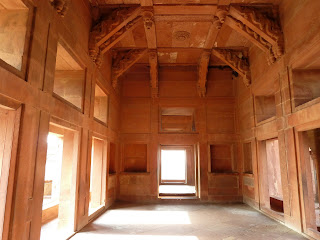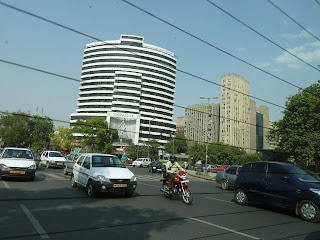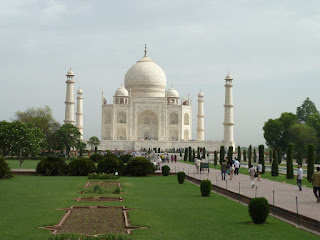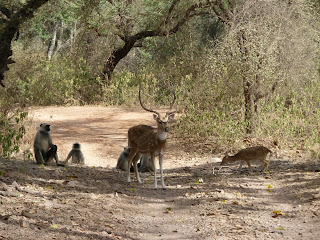





















































































May 4, 2011
Since my last blog a lot has changed with the world. I woke up one morning to the news that Osama bin Laden had been killed. My first reaction was fear of a massive retaliation. I also thought of my friends in NYC, DC and at US embassies. I also felt like I should be in NYC for that moment. But it was interesting to watch the news coverage here because the focus of the BBC, CNN and Indian channels/papers were different. Given India’s hostile relationship with Pakistan their news focused on bashing Pakistan. I can’t imagine that people in the Pakistani government didn’t know where bin Laden was, but the western news and politicians are being more diplomatic in their statements. His death is a large symbolic victory and moment of justice, but his death does not make me feel safer.
India news is also angry that the US won’t go into Pakistan and get the man involved in the attacks in Mumbai. They say we are hypocritical and once again siding with Pakistan over India in the war on terror.
Back to my travels… Mom and I squeezed in Fatehpur Sikri because we had both read about this briefly used Mughal palace. It was built by Emperor Akbar out of gratitude to a Sufi (now saint), Sheikh Salim Chishti, who predicted he would have a male heir. Maybe if the man had also foreseen that this son, Salim (later named Jahangir), would try to kill Akbar to ascend the throne Akbar might not have built this palace and mosque. It was under construction during the entire period it was used, 1569-1585. The fort/palace was abandoned for unknown reasons. Some say they lacked a sufficient water supply, but others point out the lake with a 20km circumference had good water. Another hypothesis is that Akbar had to leave to fight in Punjab and settling in Lahore made more strategic sense. Once the fighting there ceased, he moved the capital back to Agra instead of Fatehpur Sikri.
It is a beautiful palace and has a different layout than the Hindu kingdoms. The palace was more spread out with much open space and the buildings didn’t go too high. The Agra fort has a similar style. Sandstone is still the primary building material. The Mughal Empire is a Muslim Empire and so their forts include mosques and Arabic calligraphy and designs reminiscent of the Ottomans and Persians. Akbar was an extremely religiously tolerant ruler and his first three wives (of 300!) were all of different religions. Mariam was a Portuguese Catholic, another wife was Muslim and the third Hindi. In the palace of each wife, Akbar had her tastes emphasized. For example, Miriam loved painting so her palace had lots of wall paintings and a Gothic style archway. All of the wives’ religions were honored in their palace, but Akbar also insisted the other two religions be present as well. A lotus flower might be sculpted as a reminder of Hinduism.
The open-air tiered triangular structure with a dome on top was fascinating and unique. Each level had a specific purpose and each of the three wives had her own floor for religious rituals. This structure is at the beginning of the zenana area.
The royal harem at Fatephur Sikri held about 5,000 women, guarded by a legion of eunuchs (pronounced “U-nicks” in case you’re like me a didn’t know how to say the it). The size of his harem grew even more as his empire grew over the years. Apparently alcoholism and drug addiction was common in the harem and Akbar was known to have enjoyed opium. Some of the harem women were able to conduct business from behind the purdah. His favored wife, Sultana Ruqayya Begum, owned a ship that traded between Surat and the Red Sea.
If you are interested in the Mughal Empire and especially the harem and intrigues that occurred the two-part series of historical novels, The Twentieth Wife and Feast of Roses is really excellent. Salim’s 20th wife was a love marriage to Mehrunnisa (later Nur Jahan) and she wielded much influence (causing agitation among many).
Back to Fatehpur Sikri, the grounds also included a treasury that had opening in the stones that locked. Three rooms each housed one type of wealth, like gold and gems. A walkway enclosed each room so that guards could do their thing 24/7. Another building, the Diwan-i-Khas (Hall of Private Audience) had an interesting design. Akbar sat on the “throne pillar” about 15 feet off the ground and his visitors could come to him on the walkways. It is a small building as few were granted a private audience. The nearby Diwan-i-Am (Hall of Public Audience) was where Akbar would spend a couple of hours each day hearing reports, receiving gifts, etc. This hall has a large lawn courtyard in front of it and is one story. The columns are in Hindu styles. The audience members waited in areas designated by their positions with, obviously, the more prominent people being nearer the emperor. Elephants and guards stood at the back of the audience.
The large courtyard has a pachisi court where slave girls were used as the pieces. At times more than 200 people participated! No one was allowed to go home until he had played 16 rounds, which could take three months! The game had a practical purpose for Akbar because he could weigh up the talents of the players and teach them to affable. If a player got restless or impatient he was made to drink a glass of wine. Sounds like a predecessor of college drinking games!
Akbar’s sleeping quarters were modest in size I thought. His bed was impressive though – it’s raised high and is king size. :) All of the rooms would have been decorated with rugs, pillows, lighting, etc. I wish they had computerized mock-ups of what the palace originally looked like similar to what they have for ancient Rome.
We had a lackluster guide for the palace and he passed us off to his “cousin” for the religious section, Jama Masjid (Dargah Mosque). His cousin wasn’t too informative and was pathetic at keeping the vendors from bothering us, but in typical Indian fashion he took us to his family’s blanket of stone carvings. This is where the Sufi saint was buried and a mosque was also built. Dargah refers to a tomb for a Muslim saint. This complex is a large square with some amazing architectural structures. The mosque was completed in 1571 before construction of the palace even began. Akbar’s decision reflects how much religious significance he conferred on the site. However, the stepped gate was built later, in 1576, to commemorate the military victory in Gujarat. The tomb is the rectangular building in front of the ablution pool. The intricate carving still impresses me!
We learned of another corrupt scam at Fatehpur Sikri. Before we even bought our tickets kids were asking us for our used tickets and our guide took them from us and argued when we asked for them back (I much prefer audio guides because the live guides often rush you, are uninformative and try to sell you things). So it was obvious there was something sketchy involved. Our guide even told a transparent lie that his daughter uses the tickets as playing cards. It turns out that even though a small part of our ticket had been removed at the perforation that if a hole is not punched into it then it is still considered valid. So the locals try to get these tickets and then sell if to the government ticket sellers who then resell the ticket to tourists at the full rate. And they get to pocket at least a couple of hundred rupees. We kept ours and teased that we would give ours to other tourists.
In Fatehpur Sikri there are only budget accommodations so Mom got to experience more what I’ve been staying in except this place had AC and a restaurant. The staff was very friendly and helpful and gave us plastic bangles when we left. They were also proud they had “wee-fee” and we were also psyched to have free WiFi. The power went off in this town more than anywhere else I’ve been, but they had a generator for some things, which was great.
My mom recently befriended a family from Delhi when they were in Arizona. They have now become part of our extended family and invited us to join them. The summer in cooler Kashmir and had already gone there, but the husband flew back to greet us. He picked us up with a driver in Fatehpur Sikri and took us to Delhi. A very generous act because he spent 8 hours in the car that day!
He and his cousin showed us the Ba’hai Temple (lotus shaped), Parliament, PM’s house, the India Gate, and the original of 7 cities built in Delhi over the centuries (Qutub Minar). They were all beautiful structures. There are reminders of the Commonwealth Games held here a few months ago. We had one auto-rickshaw driver that complained, and rightfully so, that Tata company had a monopoly on transportation. Tata brought in their cars and buses so instead of the Games helping to bring wealth to the struggling drivers Tata made a fortune. I’m sure more bribery was involved in this maneuver.
We mostly saw south Delhi, which was only built in the last 35 years. Most of the streets and buildings are very modern and prosperous. This is definitely the upscale area. We still saw slums, bicycles, auto-rickshaws, and motorbikes, but fewer than in other areas. This area looked nothing like any other part of India I’ve seen.
While in Delhi my mom’s husband, John, also joined us. So I’ve gone from traveling alone to being part of a pack! :) Another thing I’ll have to adjust to when I hit the road on my own in a couple of weeks.
We have split up our time in Delhi, but heading to Agra. It’s actually only about 35 km from Fatehpur Sikri, but we were saving the Agra fort and Taj Mahal for after John arrived. After a quick lunch and swim in the pool we headed to the fort. It’s a beautiful, elaborate, expansive fort and palace built by the Mughals. It was constructed before Akbar, but he and a couple of successors added to it. The way it’s designed the closer you get to the seat of the emperor the more intricate the décor.
A large stone bowl in a courtyard was Akbar’s bathtub that could be transported when he was on the move. And there were a couple of wells in the zenana that were 6 stories deep. In several of the areas frequented by the emperor there were little pools that sprayed scent into the air.
In a large lawn courtyard surrounded by high two stories animals used to fight each other for the amusement of the king. The lower level rooms housed the animals. The keepers could be punished by death for an animal falling ill. This area is also near two stone slab thrones and the Hall of Public audience. Jahangir added a bell on a robe that anyone could pull “in an emergency” to speak with the emperor. But you better be confident that the matter is urgent because there were stiff penalties for frivolously using it.
After walking all thru the old Mughal halls and courtyards you see a tomb for John Russell Colvin. Random right? Well, he was killed during the Sepoy Mutiny in 1857. He climbed behind the fort walls for protection, but still couldn’t escape the rebels. This mutiny is also called the First War for Independence. Basically, stories were going around that pork and beef fat were on the cartridges the sepoys (Indian soldiers for the British) had to bite before using. This was a problem for nearly every sepoy as the Hindus couldn’t have beef and the Muslims couldn’t eat pork. This event triggered much pent up anger and an extremely violent mutiny occurred that spread throughout the British colony. Any British person became a target. The British were caught off guard at first, but put down the rebellion and conducted their own extremely violent reprisals. Up until this point the British East India Company had controlled the colony with the permission of the British crown, but after this rebellion Queen Victoria took direct control. She also made some changes meant to pacify her Indian subjects and to show her faith had sepoys being part of her personal guard.
The next morning we work for sunrise at the Taj Mahal. Unfortunately, we were late because of our driver, but it was still nice to be there early. There is more to it than I realized. In addition to the mausoleum, there are galleries where the poor were given food three times a week, guesthouses and a mosque. Jahangir’s son, Shah Jahan, built this for his beloved wife who died giving birth to their 14th child. He is now buried alongside her. She has the center position, but his tomb is larger. There tombs are surrounded with a marble wall. The white marble and alcoves of the mausoleum really does make it hover over the land. It has an ethereal feel. The delicate carving and colorful stone inlay is beautifully done.
Oh and magically we had a few drops of rain!
Now we are in the car on our way to a tiger hunt (only hunting with our eyes). Ranthambhor National Park is supposedly the best place to have a tiger sighting so cross your fingers for us.
Oh, as we’re speeding down the highway a guy stands in the middle of the lane and gestures for us to stop. Our driver slowed, but not enough so the other man leaped out of the way. Crazy! Turns out that guy was telling us to pay a toll. This was very strange considering there were actual toll booths before not people standing in the middle of the road blocking cars going 50mph. As the driver went and paid another man came to try and get our business. He is supposedly a guide for Fatehpur Sikri (not!) and thought we were going there. Then he asked if we had some token from the US to give him. You just can’t get away from people hassling you. Usually anytime our car is stopped in a city we have people knocking on our windows begging or trying to sell something.
May 5, 2011
Happy Cinco de Mayo! The drive we thought would take 3-4 hours took 7 hours. Our driver doesn’t speak English, but also doesn’t know his way around so a 5 hour drive got stretched out. And the last 2 ½ hours was on horrible roads that did not please my full bladder and upset belly. It was a fun and sometimes funny feast for the eyes though. In one city bustling with people on the street one man – naked! – walked his path with great posture and purpose. We noticed the locals were staring at him too so I guess they were as surprised as we. This was my second odd naked sighting. The other was actually a religious TV show where men were kneeling and having some rite done by a priest of sorts, but the priest was naked. He had a massive pot belly too.
I also saw my first camel herds. They are such gangly creatures, but somehow carry off a poised confident, even royal air about them. We see a lot of camel carts as well. I’m going to miss these cute animals. In contrast to this surprising elegance are the cow patties we see in the rural areas. They are dried in disks, but also block structures are made with them. I’m not sure why, but maybe they are for fuel or to be mixed with materials for their homes. We had heard that keeps the mosquitos away. Up until this long drive I had been happily amazed that I hadn’t seen any accidents. Today though we saw four! A brick hauling truck took a nose dive into a ravine, two small trucks hit each other, a truck on its side and a cart toppled. The one with the two small trucks was stirring an argument as one man pushed another. My book suggested if you’re driving and injury someone to leave the scene and drive to a police station because murderous crowds swell up.
This morning we woke up at the crack of dawn again, but this time to “hunt” tigers in Ranthambor National Park. Our jeep safari was two hours and right at the start we saw the dominant male of the park!!! T24 is seven years old and is huge. We saw him sauntering his way into a small pool of water where he stayed for about 30 minutes before moving on. We were incredibly lucky to see him since we had only one safari planned. For the Bangalore family we shared the van this was their second visit to the park and fourth safari. And this was their first tiger! Others that day didn’t see one and if we hadn’t been running (unknowingly) late we would have missed him. There are only about 30 tigers in this large park and 1/3 of the park isn’t accessible. He was such a grand sight and was very relaxed with us about 100 meters away. He looked at us some, but was content. A couple birds stood near him and one got a bit too chummy and the tiger slowly tossed his head to move the bird away.
After the tiger moved out of sight we went further into the park and actually even through the main entrance area. There were loads of black-faced monkeys, peacocks, birds of all sizes and colors (including the beautiful Golden Orioles), spotted deer, Sambar deer, mongoose and a lizard. We saw two areas with fresh female tiger tracks and were near monkeys and deer giving the predator warning call, but we didn’t see the predator. The guide said it was likely a leopard lying down whom probably knew the jeeps were there and was too shy to come out. The tigers would have already come out to drink water since it was getting hot. We did see a line of sambor deer coming down from their nighttime refuge on top of the mountain to drink water.
Up until today I had only seen two peacocks, but the park was full of them. They are beautiful and we saw one male fanning his feathers. No female in sight so maybe he was just practicing! I saw a couple in the tree with their colorful feathers hanging down, but couldn’t get pictures.
The park was a wonderful break after so many days spent in cities. The park used to be the hunting grounds for the Jaipur royalty. There were villages in the area and the villagers could hunt the smaller game, but had to leave the tiger, leopard, and other cats to the royalty. In the 1960s the royalty lost this ground and then by 1980 (I think) the land had been made into a national park. The government removed the villages, but gave the villagers new land as well as built a school and hospital. Our guide’s family was moved and he said at first they didn’t want to leave their home, but they are happy about it now. The park has also provided many of them with jobs.
Now we are making our way back to Delhi and then soon on to cool Kashmir!
No comments:
Post a Comment